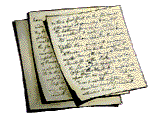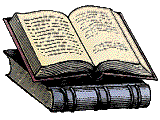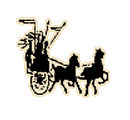
|
THE SPALDING
RESEARCH PROJECT |

|
Dale R. Broadhurst's "Spalding Papers"
"Index" -- 01 02 03 04 08 09 10 11 12 13 14 15 16 -- "Home"
Paper 12 - Part IIId
Commentary on M. D. Bown's
Book of Mormon / Spalding MS Parallels
Numbers 48-59

Revision 0a: September, 1998
Editorial and Bibliographic Information
Go Back to Intoduction & Index [ pp. 01 to 06 ]
|
ITEMIZED LIST OF PRESUMED SIMILARITIES Between Spaulding's "Manuscript Story" and the Book of Mormon Specific and single similarities have been isolated, listed separately, and numbered, with the paralleling citations from each work following. Whenever possible, direct quotations have been made. Only when necessary has discussion been utilized, and here care has been taken that the duplicating references are amply and accurately recorded -- but even so, errors no doubt will appear. This method of listing parallels is cumbersome perhaps, and has involved exceeding labor in preparation; but it seems to have the merit of providing direct comparison between the two works with a minimum of vagueness. "MS" refers to Solomon Spaulding's "Manuscript Story," the edition used being published at the Millennial Star Office, Liverpool, England, 1910, 116 pages. "BM" refers to the BOOK OF MORMON, and the edition used was published by the Church of Jesus Christ of Latter-day Saints, Salt Lake City, 1920, 522pp. Please Read These Notes First: 1. All additions to Bown's original paper are shown in blue. 2. Commentary here as a summary; For full commentary follow the links. 3. The Commentator's Personal Ratings of Bown's Parallels: * poor parallel or not a parallel: should have been dropped Some On-line Textual Resources: 1. Search the Book of Mormon: LDS and RLDS texts (side-by-side scrolling comparison) 2. Search the Book of Mormon: Current LDS edition (includes phrase search) 3. Search the Book of Mormon: 1830 edition (includes concordance functions) 4. Search the Spalding MS: Special e-text version (includes concordance functions) 5. Search the Spalding MS: Special e-text (side-by-side with 1830 Book of Alma) 6. Search the Spalding MS: LDS 1910 edition (the edition used in Bown's citations) 7. Read Holley's book: Book of Mormon: A Closer Look (Spalding / BoM Comparisons) 8. Search the Bible: King James version (includes Apocrypha & concordance functions) 9. Search Ethan Smith's Book: View of the Hebrews (includes concordance functions) |
Go Back to: Parallels 01-14 [ pp. 07 to 11 ]
Go Back to: Parallels 15-24 [ pp. 12 to 15 ]
Go Back to: Parallels 25-47 [ pp. 15 to 22 ]
|
48. The people had furnaces. MS -- Lobaska taught the Ohons "how to build a small furnace & to cast iron ware." (p. 35) BM -- "And thrice they were cast into a furnace and received no harm." (3 Nephi 28:21) Cf. also 4 Nephi 32, Mormon 8:24, Mosiah 24:23, etc. Comment summary on item #48: **** The Nephites and Jaredites no doubt possessed various types of furnaces, including metallurgy furnaces, perhaps even casting foundaries. Nephi himself appears to have been something of a metalsmith and forge operator. At least he is shown as such in the famous Arnold Friberg painting illustrating his bellows operation and tool-making story of 1 Nephi 17:8-16. So also were Lobaska and Lobaska's real-life alter ego, Solomon Spalding. Spalding tried to get a metal-working business going in frontier New Salem. And it's not beyond the realm of possibility that, when he rebuilt an old furnace there, Spalding actually reconstructed the ancient equivalent of an "Ohian" furnace. (more Comments on item #48) 49. They refined ore. MS -- "The manufacturing of Iron & lead was understood but was not carried on to that extent & perfection as in Europe." (p. 22) Cf. also p. 35. BM -- ". . . and there were also curious workmen, who did work all kinds or ore and did refine it; and thus they did become rich." (Helaman 6:11) Cf. also Ether 10:23, Mosiah 11:8, Jarom 8, etc. Comment summary on item #49: *** The more significant parallel here is based upon as much upon the Book of Mormon peoples' and the Ohians' similar large scale of operations as it is upon their common level of metals technology. The Ohians' iron ore must have come from their own Great Lakes region. The Book of Mormon peoples are also pictured as obtaining their ores locally. (more Comments on item #49) 50. They manufactured their own tools from steel. MS -- "By hamering & hardening their Iron they would convert it nearly to the consistence of Steal -- & fit it for the purpose of edge tools." (p. 23) BM -- "And we became exceeding rich . . . in iron and copper, and brass and steel, making all manner of tools of every kind to till the ground, and weapons of war." (Jarom 8) Shule of the Jaredites "did molten out of the hill, and made swords out of steel . . ." (Ether 7:9) Cf. also 1 Nephi 4:9, 2 Nephi 5:15. Comment summary on item #50: ** The Ohians and the Book of Mormon peoples made similar metallic tools, but only the latter are said to have manufactured true steel. True pre-Colombian steel is unknown in the archaeological record; so perhaps Book of Mormon "steel" was little more than Spalding's hardened iron. (more Comments on item #50) 51. These tools were somewhat similar. MS -- Lobaska taught the Ohons how to make shovels, mattocks, wheelbarrows, and axes. (p. 37) BM -- "And all hills that shall be digged with the mattock . . ." (2 Nephi 17:25) Use of the ax is quite frequently mentioned. (Cf. 2 Nephi 20:15, Enos 1:20, Alma 5:52, Mormon 6:9) Comment summary on item #51: ** Bown should have combined this information with his previous parallel. The quote from the Isaiah texts in the small plates of Nephi isn't necessarily relevant to the Jaredites or the descendants of Lehi in the New World. The Nephites would have known of the mattock from their traditions and scriptures, but that does not mean that they chose to use that tool themselves. (more Comments on item #51) 52. They coined their own money. MS -- "It is . . . provided that certain small pieces of Iron -- stamped in a peculiar manner, shall be this circulating medium, to represent property -- Each piece according to its particular stamp shall have a certain value fixed upon it -- It shall be the peculiar prerogative of the Emperor & his councellors to direct the coining of these pieces." (p. 45) BM -- "Now these are the names of the different pieces of their gold, and of their silver, according to their value . . ." (Alma 11:4), and then to verse 20 is listed the denominations of the Nephite coins. Also ". . . they did stir up the people . . . that they might get money according to the suits . . ." (Alma 11:20) Comment summary on item #52: **** While neither account calls them"coins," both the Ohians and Nephites minted and circulated "pieces" of metal that served as money. There were some differences between the two peoples' metallic pieces' composition and value, but both systems of money were essentially the same. In both accounts the description of the metallic pieces arises in the context of the larger topic of paying salaries to public officials. There are some additional sub-parallels evident in the two accounts, in regard to the potential greed and dishonesty of public servants. (more Comments on item #52) 53. They made their own cloth. MS -- The hair of the Mamoons "being sheared off at the proper season was manufactured into course Cloth . . ." (p. 18) BM -- The people of Zeniff were caused to "work all manner of line linen, yea, and cloth of every kind . . ." (Mosiah 10:5) The Jaredites made their own cloth (Ether 10:24) as did the people of Lehi and of Mulek (Helaman 6:13) Comment summary on item #53: ** Bown's obersation is valid, but hardly unexpected. Pre-Columbians were known to have manufactured various kinds of textiles, including some made from cotton. Bown missed seeing the cotton parallel and he neglected to show any similarities in the design and manufacture of the Ohian and Book of Mormon peoples' garments. (more Comments on item #53) 54. Pottery was made by the people. MS -- "The potery Business was conducted with great inginuity, & great quantities of stone and earthan ware consisting of (every kind) of vessels of every construction which were needed for family use, were manufactured in every part of this extensive country." (p. 23) BM -- The Lord speaks: "Surely your turning of things upside down shall be esteemed as the potter's clay" (2 Nephi 27:27). "Cups" frequently occurs (Cf. 3 Nephi 19:8, Moroni 5:1, etc.) as do "dish" and "vessel," but these latter in connection with the barges of the Jaredites (Cf. Ether 2 and passim.). Comment summary on item #54: * Bown's quote from the Book of Mormon Isaiah texts doe not provide any useful information on Jaredite or Lehite ceramics. Without the application of better textual citations, this supposed parallel is meaningless. (more Comments on item #54) 55. Music and musical instruments used. 12 MS -- ". . . ten musitians immediately mounted & at once, the multitude on every side sang a song. . ." (p. 13). "Musicians with instruments of various kinds, were now playing through every division of both armies -- they blowed horns, pipes & a kind of Trumpet -- & beat with sticks on little tubs whose heads were formed of parchment." (p. 90) BM -- "And the harp, and the viol, the tabret, and pipe, and wine are in their feasts. . ." (2 Nephi 15:12) ". . . the noise of the viols is not heard. . ." (2 Nephi 24:11) "Therefore, when ye shall do your alms do not sound a trumpet before you, as will hypocrites do in the synagogues and in the streets, that they may have glory of men" (3 Nephi 13:2). Comment summary on item #55: *** There is a parallel here, but Bown has neglected to cite the proper texts in order to demonstrate it. What might be better spoken of here is the commonalty of similar trumpets being sounded in Ohian and Jaredite battles. The commonalty of people dancing in both accounts might also constitute a valid textual parallel. (more Comments on item #55) 56. They practiced polygamy. MS -- ". . . wealthy men, who are young & who have but one wife, shall have the privledge (with the permission of the King) to marry another until the numbers of the single young men and single young women are made equal." (p. 29) BM -- "And now it came to pass that the people of Nephi, under the reign of the second king, began to grow hard in their hearts and indulge themselves somewhat in wicked practice, such as like unto David of old desiring many wives and concubines, and also Solomon, his son" (Jacob 1:15). This practice, however, was forbidden, "for there shall not be any man among you have it be one wife; and concubines he shall none." (Jacob 2:27) "And it came to pass that Riplakish did not do that which was right in the sight of the Lord, for he did have many wives and concubines . . ." (Ether 10:5) Comment summary on item #56: **** Polygamy is only allowable, in both accounts, only upon receipt of specific authorization of God or the King. Since the Ohian religion and government were inseparable, the permission of the King implies the consent of God. Both of the texts permitting polygamy fit rather uneasily into their scriptural contexts and both could be excised with little effect upon the contents of their respective records. The Mormon allowance of polygamy in the Nauvoo period was more or less consistent both with "the permission of the King" and by the perceived command of God. While this fact is not a textual parallel, it may add something to the various possible interpretations of Jacob's text allowing polygamy in order to "raise up seed." (more Comments on item #56) 57. There were robbers in the land. MS -- "It was tho't to be most pruiential to find out the disposition & character of the inhabitants, who were settled along the great River lest we should fall into the hands of Robbers" (p. 19). Marauding bands of savages plundered the cities during the height of the Sciotan-Kentuck war (Cf. p. 97, passim). BM -- The famed band of Gadianton robbers at the height of their power controlled "the judgment seats -- having usurped the power and authority of the land" (Helaman 7:4). Cf. also 3 Nephi 2:11, Helaman 6:37, 3 Nephi 2:18. Comment summary on item #57: ** The only real parallel here is that both texts use the word "robbers." Spalding does not tell us whether there were organized bands of robbers plundering the countryside. And there are no Gadianton bands to be found anywhere in his romance. (more Comments on item #57) 58. The people kept public records. MS --"Records are kept of the transactions of their governments. Their constitution & law are committed to writing" (p. 26). BM -- Most of the peoples mentioned kept records, as, for instance the people of Ammon: "And now there are many records kept of the proceedings of this people, by many of this people, which are particular and very large, concerning them . . . There are many books and many records of every kind" (Helaman 3:13, 15). And so on. Comment summary on item #58: *** The Nephites and the Ohians both had record-keepers and they maintained record depositories. Some records were also kept in Jaredite times. Information obtained from the records mentioned in the two accounts was used in composing the accounts themselves. (more Comments on item #58) 59. They kept sacred records apart. MS -- "A sacred Roll in manuscript is preserved among the Records of their Emperors & kings . . . All their large towns & cities have deposited under the care of a priest a sacred Roll, which contains the tenets of their Theology & a description of their religious cerimonies" (p. 26) BM -- Reference to sacred records is very common, usually used as all the records were sacred. However, note: "And these plates . . . which have the records of the holy scriptures upon them, which have the genealogy of our forefathers . . . should be kept and handed down . . . And now behold, if they are kept they must retain their brightness; yea, and they will retain their brightness; yea, and also all the plates which do contain that which is holy writ" (Alma 37:3-5). Again: ". . . Ammaron . . . did hide up the records which were sacred -- yea, even all the sacred records which had been handed down from generation to generation, which were sacred. . ." (4 Nephi 48) "Nevertheless, I have received a commandment of the Lord that I should make these plates, for the special purpose that there should be an account engraven of the ministry of my people. Upon the other plates should be engraven an account of the reign of the kings, and the wars and contentions of my people; wherefore these plates are for the more part of the ministry; and the other plates are for the more part of the reign of kings and the wars and contentions of my people" (1 Nephi 9:3-4). Comment summary on item #59: *** It may not be exactly correct to say that these different kinds of records were kept "apart" from one another in both accounts. Even so, both records speak of civil and sacred records being kept and added to through the ages. (more Comments on item #59) Go to: item #60 |
Commentary on M.D. Bown: [Index] [parallels 01-14] [parallels 15-24] [parallels 25-47] < - >
[parallels 60-78] [parallels 79-99] [Bown's Notes] [Names Index] [Editorial & Bibliographic Info.]
Spalding Studies Home Page: [Introduction] [SRP] [Broadhurst Papers] [E-mail Site Host]
revision 0a: September, 1998